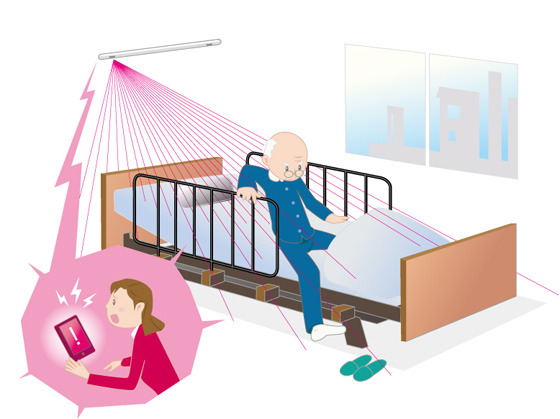Research and Development
Bedside non-contact monitoring systems for people with dementia(Owlsight)
These systems support the monitoring of senile people. If those people trip over or fall out of bed, they may suffer broken bones or hit their head. *1 It is necessary for the caretakers to know as soon as possible if the senile people are not in bed or trying leave their bed or in a dangerous posture. These systems can detect and report without any constraints to the patients if they are leaving their bed, or standing on the bed or leaning against the bed railings. These systems can reduce the load of caretakers while protecting patient’s privacy without restricting their daily lives.
Features
- No contact, no invasion, no constraints
The system uses an Infra-Red (IR) laser and a laser beam splitter to illuminate the bed with IR beams and 2 cameras with solid state sensors such as CCD collect the information regarding the postures of the patient. Therefore, the patient can have a normal daily life without any contact, any invasion, or any constraints. - Detect postures using 2 solid state image sensors
These systems have 2 solid state image sensors, one near the light source and the other about 1 meter away from the light source. Our body is moving little by little even when we are asleep. The latter image sensor captures the minute movements and the former captures large movements such as standing up or down at the same time. By using these 2 sensors, these systems can detect a patient’s leaving the bed in spite of the presence of a quilt. - Discern danger by neural network
The systems use artificial intelligence to discern postures and discern danger without any previous learning of patient’s behaviors. - Pay attention to patient’s privacy
The systems use solid state sensors such as CCD cameras. However, only light spots are recorded to protect patient’s privacy. - Report warnings to caretaker’s terminal
The systems report dangerous states of the patient to caretakers. Multiple patients can be monitored at the same time. *2
This research has been selected as a robot caretaking system development and adoption promotion project in 2013 and is approved for 2014 as well.
Technoade Association started selling the systems as a part of the robot caretaking promotion project.
*1: Accident reports at elderly care homes http://www.pref.hokkaido.lg.jp/hf/sus/houjin/houkoku/jikojirei.pdf(Japanese)
*2: Wireless LAN connection is required.
* These systems are not guaranteed to prevent accidents from occurring during caretaking. The purpose of these systems is to ease the burden of caretakers and reduce danger to the patients.


